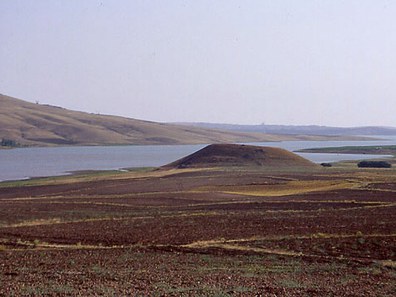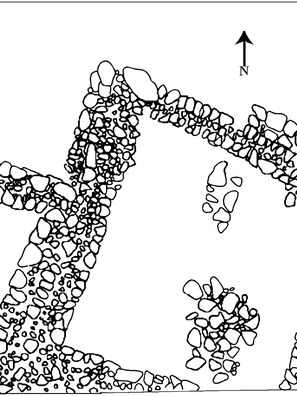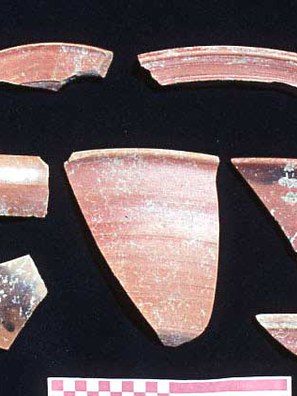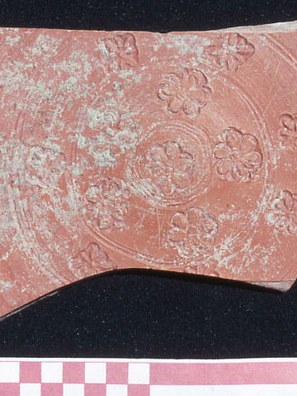
Excavations at the site of Çadır Höyük, 22 km from the trading town of Sorgun in the Yozgat Province, Turkey, commenced on July 14, 2005, and closed August 13. During several days after field excavations closed, we processed materials in the laboratory in preparation for further study in the United States. The team departed Turkey by August 18.
We are particularly pleased with the results of our 2005 Season because we were successful in answering all of the questions posed for our targeted periods. This report outlines our proposed questions for the Byzantine periods and our resulting answers to these questions retrieved during our 5-week field season.

Our primary questions regarding the Byzantine period centered on the Terrace area, north of the main mound. In 2001 we had opened a 10 x 10 meter trench in which we found substantial stone architectural remains. However, we were unable to date or phase the remains successfully. This became a serious issue due to our continued work on the Çadır mound's summit (2002–04), which had revealed substantial Byzantine remains dating to the 11th century, with at least two earlier phases underneath. By the close of the 2004 season, we understood that on the mound's summit we had evidence of occupation spanning the 8th–11th centuries, with a fairly solid representation of an underlying occupation dating to as early as the 6th century. However, we still had no understanding of who had built the Terrace buildings, when they had built them, if there were underlying earlier levels, and, finally, what was the nature/function of these buildings. Answering these questions would enable us to treat larger issues such as: 1) who were the occupants of Byzantine Çadır (i.e., farmers, religious personnel, etc.); 2) what were the subsistence strategies of the occupants; 3) was there a change in status of the occupation (i.e., wealthier, poorer, smaller, etc.) over the centuries of occupation; and 4) was the overall nature of the settlement religious, economic, pastoral, or a combination of all of these and more. To answer all of these research goals we opened an additional 10 x 10 m trench on the northern Terrace, adjacent to the one opened in 2001. We cleared a third trench on the terrace for future work, and we clarified the 2001 exposure in the original 10 x 10 meter trench.

On the first day of formal excavations we laid out and cleared our new 10 x 10 m trench (designated 940.980) just east of the original 2001 trench (designated 940.970). Even in removing the upper 10 cm of topsoil in our new 10 x 10 m trench we began uncovering architectural remains. By season's end, we had an entire trench excavated to a depth of 1.5 meters, and had exposed at least two phases of occupation, including the remains of a 1–2 meter-high wall and a flagstone floor, plaster floors, a hearth, and substantial ceramic collections. Without a doubt, the Terrace was heavily built and occupied during the Byzantine periods at Çadır.

We also deemed it wise to clean up and better define the trench excavated in 2001, to help us better understand the building phases represented. This project proved nearly as valuable as the opening of the new trench, as we were able to retrieve ceramics and observe architectural shifts that clearly demonstrate a minimum of two major building phases with at least one final reconstitution of buildings that had become dilapidated over time and due to critical events on the plateau.
The excavations on the Terrace enabled us to make substantial strides toward answering the research questions posed above. Following are our preliminary assessments of the nature of the Çadır Byzantine occupation.
Phasing


We can document what we believe to be a final reworking of the architecture, constituted by very hasty and poorly-constructed thin walls, crooked and seemingly dumped without much care, on top of the previous more substantial architecture. Based on ceramics and one coin found in 2001, this final building phase dates to the 11th century, perhaps just before, or just after, the Battle of Manzikert.
Economy
Our paleobotanical and paleozoological studies of recovered samples are ongoing. However, preliminary analysis indicates that the occupants on the Terrace were primarily engaged in farming and pastoralist industries. These structures are almost certainly domestic in nature, and therefore most likely constitute farm houses built just off the main mound where a different segment of the Byzantine population lived (Soldiers? Clergy? Wealthy landowners?). Based on the architectural remains, the earliest Byzantine occupants (those who built the 6th century buildings) were in good financial shape and lived, at least in this area of the Terrace, in large and well-constructed houses, with large rooms, nice floors, and imported ceramics.
As the centuries passed, fortunes dipped a bit. Rooms were made smaller, belongings become more locally produced, and possibly life became just a bit more difficult. Whether these changes are due to local events (a drop in trade relations or product production) or larger events in the Byzantine Empire as a whole, is a question that remains for further investigation at the site. Finally, by the last documented phase of occupation in the 11th century, the residents continued to farm and, interestingly, we have solid evidence that they housed animals in rooms immediately adjacent to their dwellings (something we do not necessarily see in the previous phases of occupation). This may be indicative of the less than stable circumstances residents on the Anatolian Plateau found themselves in during the 11th century. Whatever the reason, it is clear from building remains and styles that by the 11th century the residents on the Çadır Terrace are living lives far different from their sixth-century forebears.
Other Data
At present we have 200 square meters of excavated area on the Terrace. We believe that all the exposed architecture is domestic in nature. However, if a church, or industrial areas are present on the Terrace, a supposition we believe to be likely, it is quite possible that they will be in the near vicinity of our open excavations since we are excavating on a higher area of the Terrace; lower areas closer to the river were likely to be restricted to agricultural uses. We suspect that further excavation of this area will reveal buildings employed in non-domestic uses. Revealing such structures will certainly go far in illuminating the nature of the Early, Middle, and Late Byzantine occupation at Çadır.
An additional item of data was documented as a result of the 2005 season. We demonstrated clear evidence of building reuse. One of the hallmarks of Byzantine archaeology is that the period is represented in the archaeological record by small scale rebuilding, as opposed to large scale architecture. By applying this theory, we have been able to document relatively minute shifts in occupation, and indeed to attest to the long term use of this particular site.
Goals for the 2006 Season
In an effort to continue exploring the research areas outlined above, we plan to continue work on the northern Terrace. We wish to further define the phasing, pinning down actual dates of occupation if possible, as well as identify any more subtle architectural alterations in the earlier phases of occupation. Toward this end, we will continue work in the two open trenches, continuing to define the existing architecture and engage in some additional excavation to identify the earliest foundations and thus earliest Byzantine settlement.
We also intend to open two additional 10 x 10 m trenches adjacent to those already open. This will give us a total of 400 square meters of horizontal exposure and offer an extensive area within which we will be able to get a strong sense of the nature of the Terrace Byzantine occupation. Issues such as the size of Byzantine farm houses, inter-house alleys and roads, whether non-domestic buildings are in the vicinity, whether courtyards were present and what activities were conducted in them, and many more detailed questions about the overall character of 6th–11th century Byzantine occupation can be answered by doubling the excavated area.
We are fortunate in that even the smallest detail about the "life of the commoner" in Byzantine Anatolia will add to a database that is largely empty regarding what such settlements were like away from the church. There are few Byzantine settlements that have been extensively, or even slightly, excavated on the plateau, and of these, the interest has focused on the citadel, the monumental architecture, the churches and towers. Çadır is poised to fill an enormous black hole regarding what life was like for the majority of the population during the Byzantine centuries on the Anatolian Plateau.